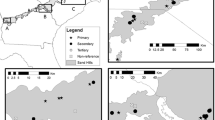Abstract
A fine-grained statisticaly robust probability sample of stream segments is used to compare two small (20,000 hectare) subbasins of the Tillamook watershed, north coastal Oregon. The two subbasins are matched with respect to several variables [size coastal climates], but vary in terms of geology and consequently land use. A total of 67 wadeable + non-wadeable sizes were identified for sampling in the two subbasins (combined) over two field seasons from a sampling universe consisting of the River Reach File 3 (blue lines on 1:100,000 maps). Target variables include an extensive array of physical habitat endpoints, selected water chemistry endpoints, species composition, and relative abundance of both benthic macroinvertebrates and fish. Field protocols generally followed those of the U.S. EPA's Environmental Monitoring and Assessment Program (EMAP).
Eleven fish species were encountered, a typically low number for coastal Oregon streams. Exploratory analysis using nonmetric multidimensional scaling revealed that 92.4% of the variation in the fish assemblages could be explained with two ordination axes. Environmental factors related to stream size and substate were the most correlated to these axes. Further, stream segments for the two subbasins tended to map in different areas of species space. Therefore, we also give unweighted probability distributions for several of the factors that heavily on these two axes by subbasins, as well as probability distributions for chemical endpoints. Results from the subset of sites sampled during the first year (21 wadeable sites) reveal: 1) differences between samples from the two subbasins relates to dream size and substrate composition that are consistent with known differences in geology and land use, 2) unexpectedly minor differences between samples from the two subbasins for stream temperature, canopy cover, and dissolved oxygen, 3) differences between samples from the two subbasins for total P, and total N, possibly related to land use, and 4) unexpected differences in samples from the two subbasins for conductivity, probably related to geological factors. Sample size for each subbasin is low and therefore our samples cannot be taken to necessarily characterize either subbasin. However, our findings are consistent with a comprehensive assessment that had been previously produced for one of the two subbasins.
All field work was completed in 8 weeks 3-person field crew. We conclude that rapid assessment protocols, based on probability samples at this level of resolution, can be a cost-effective approach to watershed analysis. This approach should be seen as a complement to, rather than a replacement for, systematic surveys that produced finer scale, reach specific information on factors such as channel complexity and cover relevant to in-stream restoration planning.
Similar content being viewed by others
References
Arneel, J.J., Axler, R.P. and Owen, C.J.: 1993, ‘Persulfate digestion for determination of total nitrogen and phosphorus in low-nutrient waters’ American Environmental Laboraty, Volume 10/93.
Bond, C.E.: 1963, Distribution and ecology of freshwater sculpins, genus Cottus, in Oregon, Doctoral dissertaion, U. Michigan, Ann Arbor, MI.
Coulton, K. G., Williams, P.B. and Benner, P.A.: 1996, An Environmental History of the Tillamook Bay Estuary & Watershed, Tillamook Bay National Estuary Project, Garibakli, OR, 68 pp. + 39 figures.
Follansbee, B. and Stark, A.(eds.): 1998, Kilchis Watershed Analysis, Tillamook Bay National Estuary Project unnumbered report, U.S. Environmental Protection Agency, 206 pp.
Ford, J., Stoddard, J. and Powers, C.P.: 1993, ‘Perspectives on environmental monitoring: An introduction to the U.S. EPA Long-Term Monitoring Project’ Water Air Soil Poll. 67, 247–255.
Gregory, S. V. and Bisson, P.A.: 1997, Degradation and loss of anadromous salmonid habitat in the Pacific Northwest, in Pacific Salmon and their Ecosystems, Strouder, D.J., Bisson, P.A. and Bisson, Naiman, R.J. (eds.), Chapman & Hall, NY, pp. 277–314.
Herlihy, A.T., Larsen, D.P., Paulsen, S.G., Urquhart, N.S., Rosenbaum, B.J.: 1999, ‘Designing a spatially balanced, randomized site selection process for regional stream surveys: the EMAP mid-Atlantic pilot study’ Environ. Monit. Assess.
Kaufmann, P. R. and Robinson, E.G.: 1997, Physical habitat assessment, in Environmental Monitoring and Assessment Program-Surface Waters: Field Operations and Methods for Measuring the Ecological Condition of Wadeable Streams, Lazorchak J. M. and Kleman, D.J. (eds.), U.S. Environmental Protection Agency National Exposure Research Laboratory, Cincinnati, OH, pp. 18–53.
Kaufmann, P.R., Levine, P., Robison, E.G., Seeliger, C. and Peek, D.V.: in press, Quantifying physical habitat in wadeable streams, Environmental Monitoring and Assessment Program, U.S., Environmental Protection Agency-NHEERL, Corvallis, OR.
Koroleff, F.: 1983, ‘Simultaneous oxidation of nitrogen and phosphorus compounds by persulfate’ in: Methods of Seawater Analysis, Grasshoff, K., Eberhardt, M. and Kremling, K., (eds.) 2nd ed., Verlag Chemie, Weinheimer, FRG, pp. 168–169.
Lazoerchak, J. M., Klemm, D.J. and Peck, D.V.: 1998, Environmental Monitoring and Assessment Program-Surface Waters: Field Operations and Methods for Measuring the Ecological Condition of Wandeable Streams, EPA/620/R-94/004, U.S. Environmental Protection Agency, Washington, DC.
Author information
Authors and Affiliations
Rights and permissions
About this article
Cite this article
Ford, J., Rose, C.E. Characterizing Small Subbasins: A Case Study from Coastal Oregon. Environ Monit Assess 64, 359–377 (2000). https://doi.org/10.1023/A:1006451420945
Issue Date:
DOI: https://doi.org/10.1023/A:1006451420945




